Made in China – cheap at a disgraceful cost
Sunday, March 10th, 2013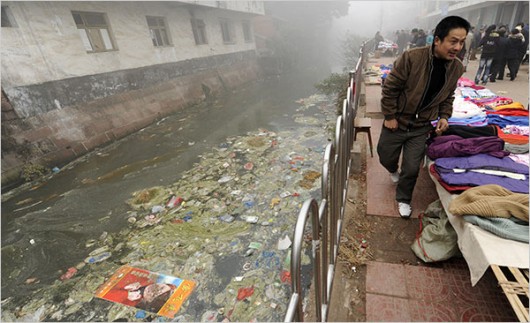 A heavily polluted river in the town of Zhugao in China’s southwest Sichuan province in 2010.
A heavily polluted river in the town of Zhugao in China’s southwest Sichuan province in 2010.Source: Peter Parks/Agence France-Presse — Getty Images
.
As economists drive growth, which is the only god they know, and lure China to becoming more westerised, China’s economy is under pressure to economically perform and keep up with the economic Jones’s. China now proudly has gained status as the world’s second-biggest economy.
But China’s economically global adage ‘Made in China‘ has come at a terrible cost to China’s environment, ecology and its people.
.
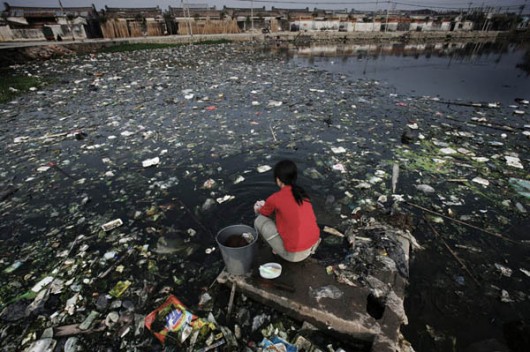 [Source: ^http://www.ecolatin.org/en/water-and-river-pollution-in-china-%E2%80%93-a-cotton-problem]
[Source: ^http://www.ecolatin.org/en/water-and-river-pollution-in-china-%E2%80%93-a-cotton-problem]
.
<<One of China’s most critical environmental problems is water pollution.
.
Nearly 1/4 of Chinese lack access to clean drinking water, over 70 percent of lakes and rivers are polluted, and pollution accidents happen on a near daily basis.
.
Water pollution not only strains freshwater ecological health, but also severely impacts human health. Today, China has a growing cancer rate, with hundreds of “cancer villages” along the banks of polluted water sources. The World Health Organization recently estimated that nearly 100,000 people die annually from water pollution-related illnesses in China, and 75 percent of disease is linked to poor water quality.
China’s water pollution crisis made international headlines following a 2005 petro-chemical plant explosion which released 100 tons of benzene into the Songhua River. Such spills are not rare in China, yet the accident and ensuing cover-up opened new space for pressuring the Chinese government to change its approach to water pollution problems. Local, regional and national environmental groups now have more opportunity to establish themselves as watchdogs of government regulators and private industry.
Working with partners across China, Pacific Environment is reaching out to local communities concerned about water pollution and helping these communities conduct legal, public relations and advocacy campaigns to reduce the impacts of water pollution on public health and the local environment. Through these actions, our partners are playing a pivotal role to ensure clean water for China’s future.>>
.
[Source: ‘Water Pollution’, by Pacific Environment, ^http://pacificenvironment.org/section.php?id=373].
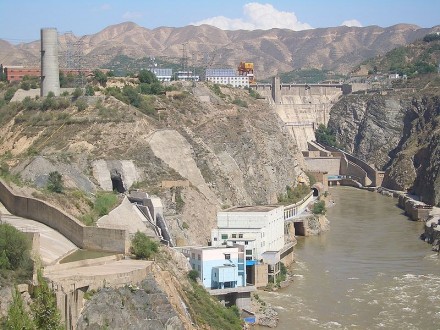 Liujiaxia Hydro Dam on the toxic Yellow River
China’s Gansu Province
Liujiaxia Hydro Dam on the toxic Yellow River
China’s Gansu Province
.
<<In recent weeks (Feb 2013), Chinese and western media have been all atwitter over the shocking levels of air pollution in Beijing and a number of other Chinese cities. But it really shouldn’t be all that shocking. After all, in 2007, the World Bank and China’s own State Environmental Protection Administration (now the Ministry of Environmental Protection) found that that as many as 750,000 people die prematurely in China annually from respiratory disease related to air pollution.
And more recently, Greenpeace Beijing reported that in 2011 in four major cities, more than 8,000 people died prematurely as a result of just one pollutant, PM 2.5 [Particulate matter 2.5 – refers to tiny particles or droplets in the air that are two and one half microns or less in width]. Anyone who spends any time in Beijing knows that the city has not yet found a way to tackle the myriad sources of air pollution from construction to cars to coal.
.
According to one report, “up to 40 percent of China’s rivers were seriously polluted” and “20 percent were so polluted their water quality was rated too toxic even to come into contact with.”
.
As frightening as the country’s smog-filled skies might be, the country’s water pollution is easily as alarming. According to one 2012 report, “up to 40 percent of China’s rivers were seriously polluted” and “20 percent were so polluted their water quality was rated too toxic even to come into contact with.” Part of the explanation may rest in the “estimated 10,000 petrochemical plants along the Yangtze River and 4000 along the Yellow River.” (And the Yellow and Yangtze are not even the most polluted of China’s seven major rivers.) On top of whatever polluted wastewater might be leaching or simply dumped into China’s rivers from these factories, the Ministry of Supervision reports that there are almost 1,700 water pollution accidents annually. The total cost in terms of human life: 60,000 premature deaths annually.
While the macro picture is concerning, even more worrying is that individual Chinese don’t know whether their water is safe to drink or not. A Chinese newspaper, the Southern Weekly, recently featured an interview with a married couple, both of whom are water experts in Beijing (available in English here). They stated that they hadn’t drunk from the tap in twenty years, and have watched the water quality deteriorate significantly over just the past few years, even while state officials claim that more than 80 percent of water leaving treatment facilities met government standards in 2011.
It is difficult to get the straight story. According to one report by Century Weekly, there are a number of reasons for differing assessments of the country’s water quality:
.
- The frequency of testing at treatment plants is too low, and only 40 percent of the treatment plants in China’s thirty-five major cities have the capacity to test for all 106 indicators in any case
- There are only a few independent water-quality monitoring bureaus, and most water testing is done in-house by the same water-treatment plant being evaluated
- There is weak transparency from local governments as to the results of the tests,and,
- No water testing accounts for the contamination that occurs from the aging and degraded pipes through which the water is transmitted to Chinese households.
.
China’s environmental challenges are long in the making, not simply a function of the past thirty years of reform. As one reporter has noted, Beijing in the 1950s transformed from a city that “did not produce even pencils” to one that boasted “700 factories and 2000 blast furnaces belching soot in the air.”
In his 1991 book ‘Environmental Management in China‘, QuGeping, China’s first director of the country’s National Environmental Protection Agency, further commented about that time: “The environmental situation quickly deteriorated. A lot of places were polluted by either smog, sewage waters or rubbish. Biological resources, forests in particular, were seriously damaged, causing several losses to the ecosystem. There was extensive destruction of the natural environment of our country.”
In the 1950s, China, like other countries, neither understood well nor had the capacity to deal effectively with the environmental and health challenges its rapid development was creating. Today, however, China has both the knowledge and the capability. In the midst of the recent air pollution crisis, Premier-elect Li Keqiang said it would take time to address the air pollution problem: “There has been a long-term buildup to this problem, and the resolution will require a long-term process. But we must act.” In the meantime, the Chinese people can only wear their masks, buy their bottled water, and hope they are not in this year’s batch of pollution-related casualties.>>
.
[Source: ‘China’s Water Pollution Crisis’, 20130122, by Elizabeth C. Economy, The Diplomat, ^http://thediplomat.com/2013/01/22/forget-air-pollution-chinas-has-a-water-problem/ . Elizabeth C. Economy is C.V. Starr Senior Fellow and Director for Asia Studies at the Council on Foreign Relations. She is an expert on Chinese domestic and foreign policy and U.S.-China relations and author of the award-winning book, ‘The River Runs Black: The Environmental Challenge to China’s Future‘ She blogs at Asia Unbound, where this piece originally appeared.].
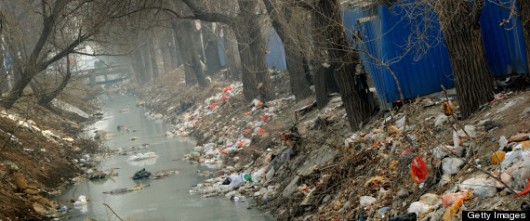 Trash clogs up a polluted canal at the edge of Beijing on March 16, 2012.
[Source: ‘Chinese Environmental Official Offered Reward To Swim In Polluted Ruian River’, 20120220,
by Sara Gates, The Huffington Post, Photo by Mark Ralston, AFP/Getty Images]
Trash clogs up a polluted canal at the edge of Beijing on March 16, 2012.
[Source: ‘Chinese Environmental Official Offered Reward To Swim In Polluted Ruian River’, 20120220,
by Sara Gates, The Huffington Post, Photo by Mark Ralston, AFP/Getty Images]
.
<<China’s government on Tuesday (20100209) unveiled its most detailed survey ever of the pollution plaguing the country, revealing that water pollution in 2007 was more than twice as severe as was shown in official figures that had long omitted agricultural waste.
The first national pollution census, environmentalists said, represented a small step forward for China in terms of transparency. But the results also raised serious questions about the shortcomings of China’s previous pollution data and suggested that even with limited progress in some areas, the country still had a long way to go to clean its waterways and air.
The pollution census, scheduled to be repeated in 2020, took more than two years to complete. It involved 570,000 people, and included 1.1 billion pieces of data from nearly 6 million sources of pollution, including factories, farms, homes and pollution-treatment facilities, the government announced at a news conference.
But the comprehensiveness of the survey also resulted in stark discrepancies between some of the calculations and annual figures that the government has published in the past.
By far the biggest of these involved China’s total discharge as measured by chemical oxygen demand — the main gauge of water pollution, which measures chemical compounds in the water by checking how much oxygen they use. These discharges totalled 30.3 million tons in 2007, the census showed.
In recent years the Ministry of Environmental Protection has done a much narrower calculation of these discharges, excluding agricultural effluents like fertilizers and pesticides as well as fluids leaking from landfills. By that narrower measure, discharges came to only 13.8 million tons in 2007, which officials described at the time as a decline of more than 3 percent from 2006 and a “turning point.”
Zhang Lijun, the vice minister of environmental protection, sought to play down the differences with previous data. He noted that the census had counted 13.2 million tons of agricultural effluents for the first time, and 324,600 tons of discharges from landfills.
The census keepers had also used updated methodologies and reached many more parts of the countryside and industrial sites than had official statistics, which helped account for the much larger figure in the census, Mr. Zhang said. Were it not for the vastly expanded scope of the survey, the chemical oxygen demand level in 2007 would stand at only 5.3 percent higher than previously calculated, he said.
Ma Jun, director of the Institute of Public and Environmental Affairs, a nonprofit research group in Beijing, said that government planners had estimated that the country’s rivers and lakes could handle only 7.4 million tons a year of chemical oxygen demand. The scale and significance of agricultural effluent was seldom recognized in previous government planning, which focused on bringing down mainly industrial emissions to around 7 million tons a year from 13.8 million tons, said Mr. Ma, a leading expert on water pollution in China.
The new total of more than 30 million tons suggests a much bigger problem. “We believed we needed to cut our emissions in half, but today’s data means a lot more work needs to be done,” Mr. Ma said.
The extent of agricultural waste could prove a more intractable problem than that of the many factories dumping effluent into China’s rivers and lakes.
“When it’s millions of farmers, it’s more difficult to bring it under control,” Mr. Ma said.
Steven Ma, of the Beijing office of Greenpeace, said that the government’s decision to calculate and release figures for agriculture would have an effect on the policy debate over water pollution in China. “Everybody knew there was a problem with agricultural pollution in China, but now there are numbers,” he said.>>
.
[Source: ‘China Report Shows More Pollution in Waterways’, 20100209, by Jonathan Ansfield and Keith Bradsher (New York Times), Zhang Jing contributed research, Photo by Peter Parks (Agence France-Presse), ^http://www.nytimes.com/2010/02/10/world/asia/10pollute.html?_r=0].
.
Poisoned River – Gold Mining Along the Biliu River’
.
 Biliu River Sludge
(Liaoning Province, south-eastern China)
Biliu River Sludge
(Liaoning Province, south-eastern China)
.
<<The Biliu River in Liaoning Province, whose source is near Yingkou City, empties into Bohai Sea at Dalian City. The upper stretch of the Biliu River is abundant in gold.
Villagers in this region for several years have been voicing their concerns regarding the impacts of gold mining on communities and the environment.
In response, in the summer of 2011, Blue Dalian conducted investigative trips to the upper Biliu River. Blue Dalian’s investigations revealed the region is impacted by six gold mines and seven gold separation plants. A total of three local companies are actively producing gold, while four companies that previously mined in the area have closed their operations. The report also includes data from publications produced by the Dalian Water Quality Supervision authority.
.
Gold: A Dirty Business
.
Gold mines in the upper Biliu River are subsurface hard rock mines, meaning rock which contains gold is dug from beneath the surface using tunnels. Once rocks are removed, two methods are used to extract gold: cyanide heap-leach and froth flotation. The cyanide heap-leach method involves leaching finely crushed rocks in cyanide liquid; cyanide binds to the gold which can then be separated out from the other materials in the rock. Froth flotation is also another chemical process used to separate gold from rock, and is generally used when gold is found in rocks that contain sulfides. Cyanide and other chemicals used in these processes are extremely toxic and can seriously threaten environmental and human health.
The primary negative environmental risks associated with these forms of gold processing include:
.
1. Human impacts: poisonous gases, dusts, and waste accumulation at and near the mining sites are harmful to the physical health of the local people and mine workers; water quality is impacted by the mines and there is risk of serious poisoning in the event of a mining waste pond failure.
2. Vegetation loss: development of mines and processing plants damages the ecology of the local landscape, including through removal of vegetation.
3. Geological and soil impacts: mines poison the soil, and soil loss is accelerated through erosion; landslides can be caused by digging or by accumulation of mining wastes, particularly if protective measures are not put in place.
4. Water impacts: water is diverted for use in the mines and is then no longer available to support ecological functions. Surface water pollution and underground water pollution is common, particularly through waste water leaks, which are likely in the event of heavy rains.
5. Wildlife impacts: waste water contains cyanide and other chemicals which are extremely poisonous and which may kill fish or other aquatic life.
.
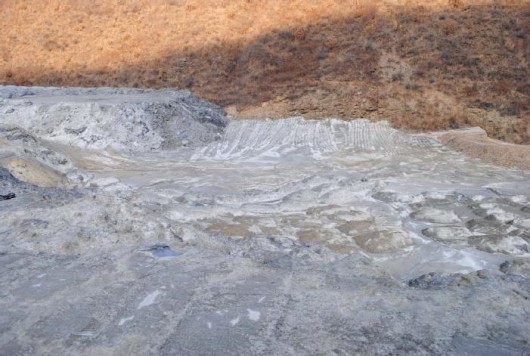
.
Biliu River Gold Mining Companies: a History of Negligence
.
There are three mining companies actively mining in the upper Biliu River watershed at present: Xinlong Mining Corporation, Futian Mining Corporation, and Futian Mining Corporation Flotation Factory.
Xinlong Mining Corporation, a local state-owned corporation, was visited by Blue Dalian during summer, 2011. According to the local Environmental Protection Bureau, the Xinlong Mining Corporation has accumulated more than 1,000 tons of waste residues at the site, far beyond the waste residue carrying capacity permitted. The investigation team observed piles of waste ore and accumulated waste residues held back by a low dam which were susceptible to being washed into the Biliu River in the event of a heavy rain.
The investigation team also learned that several years ago, waste residues directly leaked into Biliu River by the Xinlong Mining Corporation killed local livestock. Villagers living beside Xinlong Mining Corporation operations also told Blue Dalian that they have had difficulty selling their grain crops, due to concerns that the grain may be contaminated with heavy metals through contact with mine waste. Local people have tended to keep silent about these pollution issues because many of them work at the mine.
People living near Futian Mining Corporation operations told investigators about a suspected cyanide toxin accident. A massive fish kill occurred, and many residents developed thyroid problems, had difficulty breathing, and developed impaired eyesight. Local villagers insisted the government release data on water quality of the local river and information on the contents of the company’s waste water ponds, but the government never responded. The factory initially agreed to give monetary compensation to villagers whose health was impacted by the accident, but later broke that promise. Investigators learned from villagers who had connections inside the mine that no protective measures to prevent sewage containing cyanide from polluting the Biliu River were in place, though the company covers toxic residues with dirt so that they are out of sight of inspectors. The villagers now drink water from neighboring villages instead of the local groundwater they have relied upon for generations.
Primary Environmental and Human Health Concerns of Mining on the Biliu River
Threats to the health of local villagers: the Xinlong Mining Corporation uses cyanide heap leach method to extract gold, which produces waste water and residues that contain cyanide. Cyanide is extremely toxic and it is suspected villagers have already been poisoned.
Water environmental safety: gold mines along the upper Biliu River are located near tributaries to the river, and mine tailings ponds were found be located close to these tributaries. Tailings ponds were observed to be poorly located and managed, and their size and number was beyond the carrying capacity for the area. Further, dams used to contain the tailings are made from compressed earth and consequently are not water tight. According to Chinese safety standards for tailing pond construction, all the ponds observed along the Biliu River do not meet normal safety standards.
Government data shows that the water quality of the Biliu River is much lower than other sections of the river, especially for sulfate radicals, cyanide, and some heavy metals. Waste water samples collected from the Xinlong mine area were tested and found to contain more mercury and cyanide than is permitted for surface water. This is not surprising given mining waste water in this area flows directly into the Biliu River.
Heavy metal pollution in the soil: gold mining has led to the accumulation and compounding of many heavy metals – including arsenic, lead, cadmium, and zinc – in the soil environment in this area. Soil becomes polluted with heavy metals through leaks in the mine tailings ponds.
Drinking water safety in Dalian City: the Biliu River reservoir supplies Dalian City with a million tons of drinking water per day, which accounts for the overwhelming majority of the water supply in Dalian. During rain events, mine tailing in the upper watershed may directly leak into the Biliu River. The cyanide and heavy metals accumulated in these tailings may pollute the river, leading not only to local water quality impacts but a potential water crisis for Dalian City. There are already some cases in China where hundreds of people have been poisoned by water containing high amounts of cyanide which entered drinking water supplies after heavy rain storms.
.
Suggestions for Protection of the Upper Biliu River
.
1. Regular supervision of cyanide pollution and other heavy metal pollution along the upper Biliu River. The local environmental supervision department should regularly test cyanide content and other heavy metal content in the soil, surface water, and groundwater at and near the mining sites. At same time, the department should evaluate the risk of accidents and take protective measures.
2. Heavy metal cleanup and ecological recovery. Clean up and ecological recovery is needed to remove heavy metals and decrease the toxicity of the soil in and near the mines. This is important to the recovery of normal functions of soil ecosystem and reducing heavy metals being transmitted to the food chain and groundwater.
3. Establish an emergency water pollution accident mechanism in Dalian City. First, Dalian should store water in case of a water pollution emergency. A water reserve could reduce the dependence on the Biliu River and assure water supplies if an emergency happens. Second, an early warning system should be established. Related departments should punctually notify citizens to suspend water use and mobilize other water sources.
4. Strengthen integrated watershed management of the Biliu River. Dalian City should coordinate Biliu River management and development with upstream Yinkou City, which is heavily invested in mining in the upper watershed. Working together can help ensure that the river can be sustainably used and managed into the future, and that less resource intensive industries can be developed in the region.
5. Strengthening environmental supervision of mining companies. Regulators need to ensure companies improve production techniques in order to increase efficiency and reduce pollution, and that companies safely handle wastes and where possible, recycle some of the resources contained in the mining waste products.
.
[Source: ‘Poisoned River – Gold Mining Along the Biliu River’, 20111117, Pacific Environment, ^http://pacificenvironment.org/partner-report-poisoned-river—gold-mining-along-the-biliu-river–nov-2011ch].
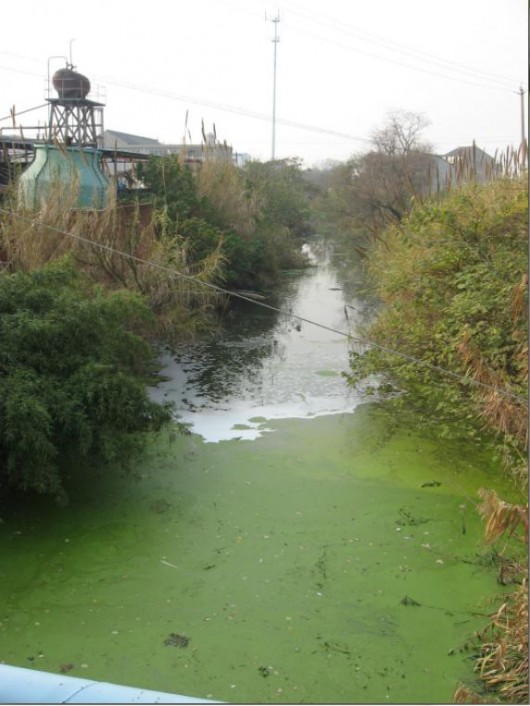 One of the many thousands of dead streams across China
[Source: ^http://www.dispatchesfromchina.com/2010/06/]
One of the many thousands of dead streams across China
[Source: ^http://www.dispatchesfromchina.com/2010/06/]
.
The Sad Story of an Environmentalist in northeast China
.
<<Forty-five-year-old Lv Qingrong lives in a village 10 kilometers away from the Biliu River in southeast China. The family has lived in the village for 14 generations. In his childhood, Lv Qingrong and his friends played by the riverside catching fish and shrimp. By the river, there was a thick forest, visuals of which are deeply engraved in Lv Qingrong’s mind.
“There were lots of trees in the mountain and there lived all kinds of animals. In the river, you could find fish, turtles, shrimp and crabs. These memories are still so vivid and dear to me now.”
In 1984, when Lv Qingrong was 21, he retired from the army and returned to his hometown in the countryside of Yingkou city in Liaoning Province.
“At the time, there were very few trees left in the mountain and water levels in Biliu River dropped dramatically. There were garbage and sometimes dead animals along the river banks. I was so sad seeing all this.”
Lv Qingrong started his garbage collection efforts in 1984. One day in spring when Lv Qingrong and a relative passed the river bank on the way to work, he came across a pile of firecrackers abandoned near the river. “Let’s deal with this first,” he said to his relative.
He started collecting clearing out the pile of firecrackers. Later, it developed into a massive project to clean the river banks.
Since then, Lv Qingrong took several bags and went to pick garbage by the river. Even in the following years when everyone had a chance to make money thanks to the government’s reform and opening up policy, Lv Qingrong didn’t stop picking garbage. Many people, especially his family members, did not understand him and sometimes got irritated with him concentrating on something they thought was useless.
In July 28th, 1981, the village was hit by a mudslide in which 300 people were killed.
“Why did the mudslide happen? When forests are destroyed by practices such as burning vegetation for land reclamation, over grazing and cutting trees for firewood, soil is easily washed away without the cover of vegetation, and mudslides occur. It is human beings who destroy their own environment and life.”
When he realized that picking garbage was not a permanent solution, Lv Qingrong decided to plant trees on the mountain. In 2000, even though his family was against it, he contracted 23 hectare of deserted land in the mountain after taking a debt of 110,000 yuan. His wife started to quarrel with him after the family became dirt poor and the couple ended up getting a divorce in 2003. His youngest son had to leave home and work in a big city to fund his own education.
After the divorce, Lv Qingrong continued to work towards preserving the environment around the mountain area.
.
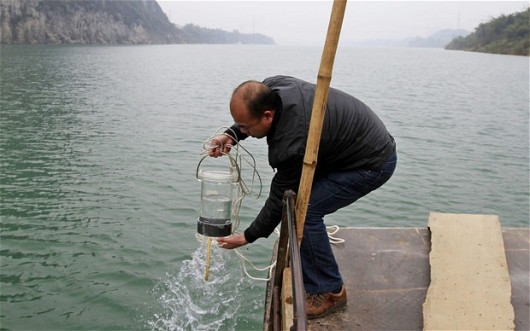 A man collects water samples from the polluted Longjiang River in Liuzhou, Guangxi Zhuang autonomous region. The authorities dumped hundreds of tons of aluminium chloride into the Longjiang River in an effort to dissolve tonnes of dumped cadmium.
[Source: ’20 tons of cadmium poisoning vital Chinese river’, 20120201, by David Eimer UK Telegraph (in Beijing),
^http://www.telegraph.co.uk/earth/environment/9053671/20-tons-of-cadmium-poisoning-vital-Chinese-river.html]
A man collects water samples from the polluted Longjiang River in Liuzhou, Guangxi Zhuang autonomous region. The authorities dumped hundreds of tons of aluminium chloride into the Longjiang River in an effort to dissolve tonnes of dumped cadmium.
[Source: ’20 tons of cadmium poisoning vital Chinese river’, 20120201, by David Eimer UK Telegraph (in Beijing),
^http://www.telegraph.co.uk/earth/environment/9053671/20-tons-of-cadmium-poisoning-vital-Chinese-river.html]
.
“What made me sad were misunderstandings from other people, especially my family members. I sometimes doubted myself and wondered if I could keep going. But every time I came to the river, I became clear and focused again. I was sure that what I was doing was right, so I became determined to continue.”
In addition to bearing the brunt of people’s misunderstandings, Lv Qingrong was struggling in other ways at that time. Without any home appliances or decent furniture, Lv Qingrong couldn’t even afford a proper New Year’s dinner to celebrate China’s most important holiday; the Spring Festival.
“I was poor and alone on New Year’s eve. I couldn’t even afford a meal of dumplings because I had given all my money to the bank to pay the debt. I wrote a couplet to celebrate the festival. It said ‘I don’t eat dumplings because I don’t have money. There’s nothing I can do, but setting off a string of firecrackers to celebrate the New Year.'”
Lv Qingrong is a big fan of traditional Chinese poems and when he feels lonely or sad he also writes them. He has had more than 100 poems published in popular Chinese magazines and newspapers. His favorite writer is the ancient Chinese poet Po Chu-yi (白居易) who lived some 160 years ago and was best known for his ballads and satirical works. Lv Qingrong recites his favorite Po Chu-yi poem.
“Don’t say all the living beings are petty and low. They have the same flesh and blood. Please don’t kill the bird on the tree, Her fledglings are expecting their mother in the nest.”
.
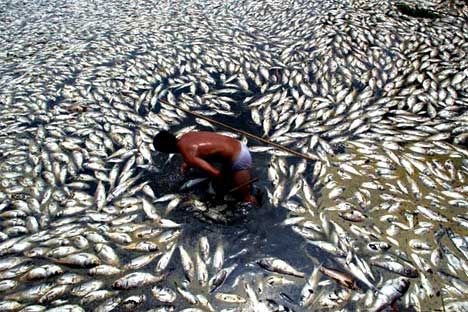 [Source: ^http://www.treehugger.com/corporate-responsibility/the-price-of-chinas-pollution-and-its-environmental-catch-22.html]
[Source: ^http://www.treehugger.com/corporate-responsibility/the-price-of-chinas-pollution-and-its-environmental-catch-22.html]
.
Eight years have past since Lv Qingrong started to reforest the mountains and his efforts haven’t been in vain. The once deserted area is now covered with young trees and animals have returned. In the river people can see salamanders again, after they had almost become extinct.Contented with the results, Lv Qingrong still lives a poor life alone. Some people suggest he could make money by selling wood or breeding sheep.
However Lv Qingrong is reluctant to use anything from the mountain. So he is known as a poor millionaire who owns a goldmine but has not a penny to spend.Despite other people’s doubts, the environmentalist’ efforts continue. In 2006, he initiated the “Biliu River Water Resources Protection Association”. There are already 200 members, ranging from municipal officials to primary school students. They come from his hometown and from the neighboring cities of Yingkou and Dalian.
“The officials are more persuasive then I am when we go to spread environmental protection messages to students. Environment education should start with children. We teach them about garbage disposal and proper ways to deal with used batteries. The children have also learned to protect animals. The overall awareness of environmental protection will improve if we start to educate them.”
In order to increase awareness about river protection, Lv Qingrong has erected a monument at the source of the Biliu River and engraved water protection slogans along with an introduction to the history of the river. With more government attention nationwide on environmental protectionand with increasing interest from people in his hometown, everything seems have taken a turn for the better. Lv Qingrong’s eldest son, who’s in his early 20s, has been emulating his father when it comes to river protection.
“The protection of the environment has become a hot topic in our village. People often come to me and inquire about environmental issues. I’m happy more and more people have become involved.”
Forty-five-year-old Lv Qingrong is resolute in his dedication and focus.
“I will stay and keep watching the river for the rest of my life.”>>
.
[Source: ‘The Sad Story of An Environmentalist in Northeast China’, 20080921, by Wu Jia, CRIENGLISH.com, ^http://english.cri.cn/4026/2008/09/21/1241s407576.htm]








